Emily Williamson from South London Sling Library explains why carrying your baby in a sling is so important and can really make your life as a new mum easier.
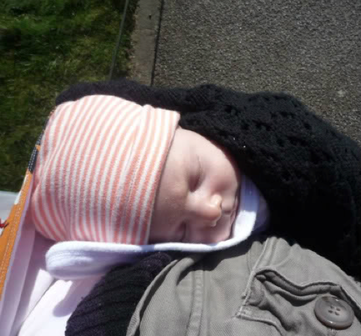
Get Your Hands Back!
If you’re a mum, then you’ll have experienced just how difficult it can be to get things done around a demanding small person. There are loads of products out there that aim to help but the one thing I‘d recommend that anyone buy if they want to make their life as parent easier would be a baby carrier or sling. More and more parents are discovering the practical advantages of using a baby carrier and now even scientific research is confirming many of the benefits of using a baby carrier or sling regularly. And with all the new and improved designs available, using a sling can be very comfortable, enjoyable and attractive too!
My Story:
First Expecting
When I was expecting my first baby I read about the importance of keeping your baby close to you, and how using a carrier can help you and your baby to form a secure attachment bond. So ‘baby carrier’ was added somewhere to the bottom of my huge list of things I’d read that I ‘needed’ for the new baby. Little did I know when I bought it just how invaluable that first carrier would be; I had no idea that using baby carriers and slings could (or would) change my preconceptions of children and parenthood, let alone my life as a parent.
Babies Defy Expectations
I’d imagined using the carrier just while my baby was very small and when we were out of the house. I just hadn’t considered the possibility of carrying him for longer than about an hour at a time or of carrying a larger baby or toddler until I’d actually experienced a real baby. Like many babies, the only thing that was guaranteed to comfort my baby son was being held and so for the first 4 months the only way to get anything done was to pop him into the carrier on my front; that way he was happy and I had my hands free to get on with things.
As he grew into an independent and confident toddler he still wanted carrying regularly – needing the reassurance of close physical contact at the end of a long walk or play, or even just at home when he was feeling unwell. Unfortunately he very quickly grew out of that first carrier, and though I tried various other options, I just didn’t find the information I needed to help me to carry a growing baby and toddler comfortably.
The Second Time Around
By my second child more information was increasingly available and I was able to find out about many more carrier and sling options and how to use them comfortably. Though I never intended to use slings full-time, our buggy has been abandoned in the shed barely used. With her safely and snugly strapped to me I’ve never had to negotiate her in a buggy through crowded streets, shops or on public transport; I could hold my son’s hand while crossing the road without having to balance a buggy single handed, and (most importantly) I could keep doing all the things I usually did with him without ever having to leave my new baby.
I still use slings to comfortably carry my daughter (now 27 months) when we’re out for a long day, in busy crowds where she might get scared or lost, or just need to get somewhere faster than she can walk.
Carrying Forward
I’ve found out a huge amount about the benefits of carrying babies regularly and the advantages of using good quality, ergonomically designed carriers. So I try my best to give unbiased information to help others to make the best choice for themselves and their children. Carrying my children has definitely made me (and them) happier and I hope I can share that with as many others as possible!
And (because you don’t just have to take my word for it) here are some more reasons why using slings can work so well for you as a parent:
Benefits for Your Baby
Human babies are very dependent; they’re not designed to be left alone and most would prefer to be carried almost continuously for the first months of their lives. Scientific research has shown that regularly using a suitable sling can benefit your baby in the following ways:
Safe, secure + included: Your baby is exactly where they want to be – with you! Because you’re so close, they’ll feel safe and secure that their needs are able to be met. Caring physical contact with young babies aids healthy brain development. Your baby is at the right level to be a part of your conversations and share your daily experiences with you. Regularly carried babies spend less time crying and more time in a state of quiet alertness, taking in and processing new information and experiences. And when they get tired, a sling can also provide a safe, comfortable place for them to nap.
Good head, spine, pelvis and hip support to aid optimal physical development: When carried in a recommended carrier type and position, your baby is supported in the optimal position for healthy spine and hip development and the tiny physical adjustments that they make to the movements of carrying helps develop their muscle tone and sense of balance.
Comfortable and settled: Your baby will be comforted by the movements of your body; they have more stable heart and breathing rates and find it easier to settle and sleep. Being held in an upright position helps them to digest more effectively and remove discomfort. Babies who are carried regularly tend to be more settled during the day, and sleep better at night.
Benefits for parents
Close to your baby: Being so close to your baby helps you to ‘tune in’ to how they communicate what they want, you will immediately notice if anything is wrong and you’ll learn to predict their needs. Using a sling from birth helps to establish successful breastfeeding. Being in close proximity to your baby has been shown to aid parent-baby bonding and to ease symptoms of post-natal stress and depression.
Convenient and Hands Free: You’ll have both hands free to be able to get on with your day too. With your baby calmer and more settled, you’ll have less stress and more time to meet your needs (and those of older children). And when out and about, slings are often much easier, less bulky and more convenient than other baby transport methods.
Good for you: Not only does carrying your baby using a suitable and well-fitting carrier support and protect your spine, abdominal and pelvic floor muscles (essential for a post-natal mother), but it’ll also provide you with low-impact and gradually increasing core strength training. You’ll be carrying at least 3kg more in weight, which burns significant calories too!
Comfortable: If well fitted and used correctly, baby carriers are very comfortable to use for significant lengths of time, even with children up to age 3 or 4. Babies are designed to fit against your body and when their weight is supported close to your centre of gravity they are much more comfortable to carry than a backpack.
Benefits for older babies too
These benefits really aren’t limited to the first months of a baby’s life; as your toddler becomes increasingly independent, then a sling or carrier can provide a safe and reassuring base for them to return to when they’re tired, upset or just need a time out from their busy days of growing and learning. Most children will not walk for much longer than 30 minutes or so until they’re nearly 2 and most will still want to be picked up and carried for short (or sometimes even long) periods until they’re at least 3 or 4. Having a sling or carrier handy in your bag gives you the ability to do this easily whilst giving your arms and back the support they need and without needing to always have a buggy with you ‘just in case’.
What Types of Carriers are There?
There are many types and brands of baby carrier available, offering various different features. Here are the main types:
Mei Tais (pronounced ‘May Tie’) have a rectangular shaped body and fasten at the waist and over the shoulders using securely knotted ties that wrap around you and your baby. Depending on carrier size and features, Mei Tais are suitable from newborn to toddler and can be worn on the front, back or hip. A Mei Tai is a great option if you’d like to share a carrier between different sized adults and children, as the carrier will adjust to fit as you put it on, without needing to change any settings before use. Brands of Mei Tai include Babyhawk and Hop-Tye.
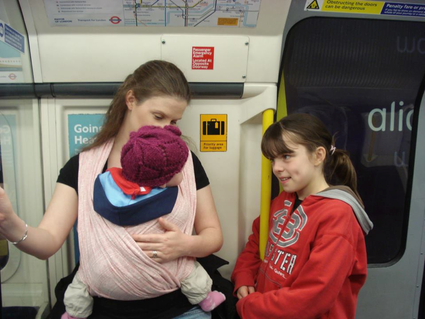
Ring Slings and Pouches are worn over one shoulder and can be used for front or hip carries. They are suitable from birth to toddler depending on the features and fabric, are quick to use, and easy to use for discreet breastfeeding. They are small and convenient to carry around, but will not be as supportive as 2-shoulder options for longer use. A ring sling is a length of fabric threaded through rings to secure and to snugly fit both parent and child. Pouches are essentially a loop of fabric worn across the body to form a pocket for a child to be carried in. Though some are adjustable, pouches tend to offer a less custom fit than a ring sling. Brands of Ring Sling and Pouch include Maya Wrap and Hotslings.
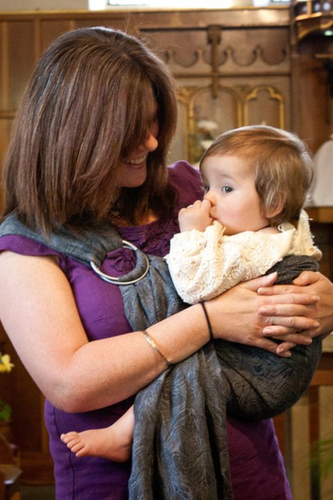
Soft Structured Carriers (SSCs) are soft, back-pack style carriers that fasten with buckles around your waist and over your shoulders. They are designed to fully support your child’s weight close against your body for comfortable carrying over longer periods and are suitable for babies and/or toddlers depending on the carrier features and size. Some are suitable from newborn, though may require adaptions or inserts to ensure a good, safe fit. Most SSCs can be used for front and back carries and many can also be worn on the hip. Brands of Soft Structured Carrier include Ergo and Manduca.
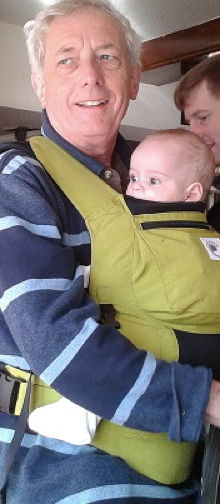
Mainstream Front Carriers are widely available and work by fastening your baby into a harness and then fastening the carrier onto you. Most are suitable from newborn and are suitable for front carries only, though offer a facing outwards position. Most parents find that they are comfortable for up to about 4-10 months. These carriers do not always offer baby the levels of thigh support recommended for healthy hip development, especially beyond 3 months. Brands of Soft Front Carrier include Baby Bjorn and Tomy.
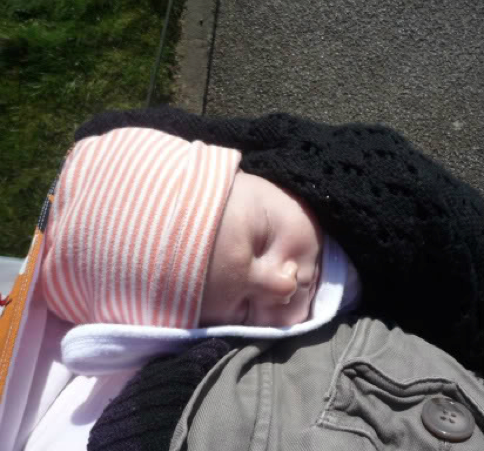
Wraparound Carriers come in two types – stretchy and woven (or non-stretchy) – both types are lengths of specially designed fabric that you wrap around yourself and tie to carry your baby securely. All wraparound carriers offer great support and comfort and are easily shared between parents. Stretchy wraps are long lengths of soft stretchy jersey fabric that can be used for front and hip carries. The only carriers really suitable for premature babies, these are fantastic for using with newborns and smaller babies, and are usually suitable for up to around 6-12 months. Woven wraps are lengths of specially woven non-stretchy fabric suitable for a wide range of front, back and hip carries from birth to age 3+. A woven wrap is the most versatile and adaptable way to carry your child, and when tied correctly will often be able to provide the most comfortable and supportive fit.
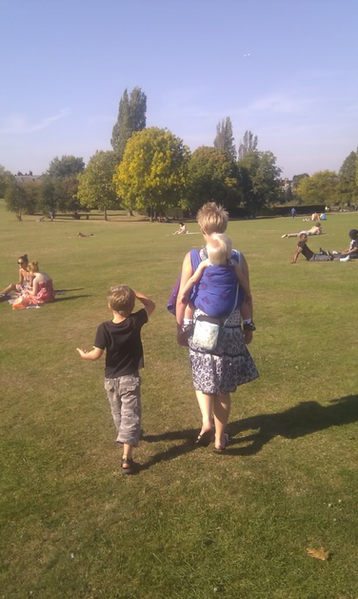
How do I choose?
Once you get over the bewilderment, all that choice means that there really is a sling for everyone. Take into account factors like how long you’d like to carrying your baby for and whether you need to share a carrier between different sized adults. It’s worth bearing in mind that, as with most things for babies, you’re likely to end up needing more than one carrier to really last you comfortably from birth to toddler. The best way to really find out what will work for you is to try out a few different types.
Regardless of what type you go for, when looking for a baby carrier the minimum that a carrier should offer is:
Full, comfortable support for a baby’s spine, head, pelvis and thighs: Your baby’s spine and head should be fully supported according to their developmental needs and you shouldn’t feel that you need to support them with your hand. For comfortable carrying and healthy hip development, your baby should be supported in their natural ‘froggy legged’ position with their knees above their hips.
Weight comfortably distributed for the carrying adult: The most comfortable carriers hold your baby in the same position that you naturally hold them in your arms (or in a piggy back position). Look for carriers that easily adjust to fit you and that hold your baby’s weight close to your body. Do be wary of advertised weight ranges – these represent what a carrier is strength tested to withstand, not always what age child it’s actually suitable for in practice.
It’s straightforward for you to use – all baby carriers require a little practice and different fastening methods suit different people. It’s really difficult to know what you’ll prefer so it’s best to try a carrier before you buy it.
How to find out more
Convinced? There’s lots of ways to find out more about slings and carriers:
Online: there are many useful sites with sling and carrier information; www.slingguide.co.uk is a great place to start. Most good quality, comfortable carriers and slings are only available to buy online and many specialist retailers are very happy to help advise on what to choose.
At a Sling Meet: informal social meetings of parents who use (or want to find out more about) baby carriers – see www.slingmeet.co.uk for more details of regular London meets.
At a Sling Library: where you can get advice and try on or borrow carriers. You can find out more about the South London Sling Library, plus lots of sling information and carrying tips at www.southlondonslings.co.uk
By using the services of a Babywearing Consultant: who can offer professional, personalised recommendations and teach you how to use carriers safely and comfortably.
Emily Williamson
Emily is mum to Arthur and Isobel. She runs the South London Sling Library and is a qualified Babywearing Consultant, offering weekly free drop-in carrier demonstrations and advice as well as sling and carrier hire, private consultations and small group workshops. For more details see www.southlondonslings.co.uk or email Emily at southlondonslings@hotmail.co.uk

